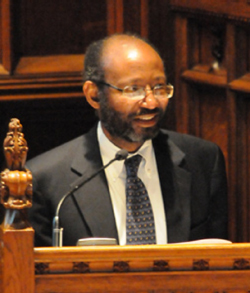Understanding How Prejudice Plays Out
In 2008, the General Social Survey, an initiative of the National Opinion Research Center that conducts basic scientific research on the structure and development of American society, asked a nationally representative sample a series of questions that gauged prejudicial attitudes. In his first Sachs Lecture at TC this past fall, Samuel Lucas, Professor of Sociology at the University of California-Berkeley, contended that the answers reveal that students are virtually guaranteed to be exposed to a prejudiced teacher at some point in their elementary and high school educations.
Although it reflects a decline in prejudice, the Survey nonetheless demonstrates that girls, African-Americans, and gay boys are very likely to encounter at least one teacher who is prejudiced against them. Rather than focusing on the likelihood that individual teachers will be prejudiced, which has diminished in recent years, Lucas instead suggested considering that each child will have at least 36 teachers before graduating high school and then determining the likelihood that one of those teachers will be prejudiced.
For example, 32 percent of teachers agree with the statement: “It is better for a man to work outside the home and for a woman to take care of the family.” Thus, explained Lucas, it is a virtual certainty that at some point, one of a girl’s 36 teachers will be someone who believes she should be educated towards the goal of taking care of a family. Similarly, students are virtually guaranteed to run across at least one teacher who believes “Most African Americans do not have the motivation to pull themselves up out of poverty.”
This is a serious concern, said Lucas. A teacher’s belief that a student lacks motivation, for example, “places everything that teacher touches into play.” Teachers grade papers, choose lessons and provide opportunities for advancement. Lucas noted that it “doesn’t require maliciousness to subtly or not-so-subtly support boys and girls differently.” If teachers believe a girl belongs in the home, they may educate her towards that end. “This may feel nurturing for the teachers.”
Such findings suggest a need for research into the possible pathways through which a prejudiced teacher can affect students, said Lucas. Prejudiced teachers are modeling their attitudes for both targeted and non-targeted students. Teachers also allocate opportunity for pupils, so they may be distributing resources and opportunity on the basis of their prejudices. Finally, teachers may be supporting their students differently due to their prejudices.
“Differential support may matter greatly,” Lucas said, even if the pathways are subtle. Teachers “may encourage the child or withhold encouragement, engage the child in dialogue or remain silent, rejoice at the child’s success or ignore it, comfort the child upon failure or let sadness fester.” Lucas called for further research into just how these differences will affect a child when she does enter the classroom of that prejudiced teacher she is virtually certain to encounter.
To view the entire first Sachs lecture, visit http://bit.ly/gvSF Z1.
Lecture Two: Fighting the Status
Quo
Inequality is stubborn. This is often the resigned
conclusion of frustrated reformers in education and other policy areas. But why
is it so stubborn? Understanding why inequality persists is a long-held concern
for Samuel Lucas, Professor of Sociology at the University of
California-Berkeley. In his second Sachs Lecture at TC, Lucas argued that
education reform must deal with what he called effectively maintained
inequality (EMI): structures and attitudes that reproduce inequality and breed
resistance to change.
“Society by nature is resistant to change from the
status quo,” Sachs said. “But structures produce that resistance.” He presented
data that showed how, for instance, children of parents who did not complete
high school are more likely to have inadequate reading skills and even worse
mathematics skills. Children of less-educated parents were also more likely to
drop out between 10th and 12th grades. The broader picture, Lucas argued, was of
“profiles of educational inequality” that endure despite small improvements.
This, Lucas argued, should instill caution about
reforms that simply aim to expand education resources: “If the inequality
patterns are embedded, it won’t help.” He pointed to both quantitative and
qualitative dimensions of inequality that entrench patterns of advantage. For
instance, students need information to make choices, but access to good
information varies widely. “Some face options with poor information or no
information,” in part because parents may be less equipped to provide it.
Lucas said his research finds EMI present not just in
the United States but in a set of 15 countries that he and colleagues are
researching. He aims to present that research in a book, but for now he offered
some advice for would-be reformers. He stressed anticipating and disarming
resistance from those who are currently advantaged, contrasting “confrontation”
versus “stealth” approaches to reform and emphasizing the importance of
well-chosen reform language. Advantaged parents will more likely oppose
“de-tracking,” for instance, than “individualized instruction.”
Lucas conceded his research did not make him
optimistic about the possibilities of substantially reducing inequality anytime
soon. But he argued that understanding how inequality reproduces, not just at
the macro level but down to information and attitudes, is essential for any
reform to succeed: “Behind the graphs are actions of individuals that sustain
inequality,” he said. Otherwise many expensive and well-intended reforms will
have little effect on inequality. “If you recognize that,” Lucas said, “you’re
in a better position than if you just think you’ve done your job by expanding
access.”
To view the second Sachs lecture, visit: http://teacherscollege.blip.tv/file/4794074/
Published Monday, Dec. 20, 2010
